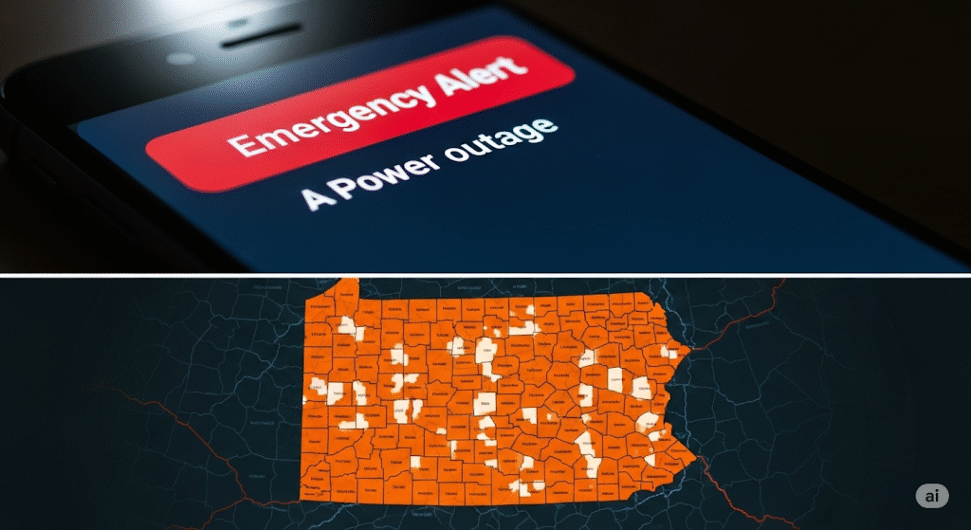When the Lifeline Fails – Pennsylvania’s 911 Scare
In moments of crisis, a single number stands as a universal symbol of hope and immediate aid: 911. It’s the lifeline we instinctively reach for, connecting us to police, fire, and emergency medical services. But what happens when that lifeline falters? This critical question became a stark reality for millions across Pennsylvania on Friday, July 11, 2025, as the state’s advanced Next Generation 911 (NG911) system experienced widespread, intermittent outages.
The disruption, which left residents scrambling for alternative emergency contacts and public safety officials working tirelessly through the night, underscored the fragile reliance on complex technological infrastructures that underpin our most vital services. While services have largely been restored, the incident has ignited a crucial conversation about system vulnerabilities, emergency preparedness, and the evolving challenges of maintaining a seamless emergency response network in the digital age.
This in-depth blog post delves into the recent Pennsylvania 911 outages, dissecting what exactly happened, the immediate responses, the broader implications for emergency services, and the indispensable lessons we can all learn to enhance our personal and community-level preparedness. From the technical glitches that sparked the crisis to the swift, coordinated efforts to restore service, we’ll explore every facet of this trending incident, aiming to provide a comprehensive, human-centric understanding that goes beyond the headlines.

The Timeline of Disruption – Unpacking the PA 911 Outage
The events of Friday, July 11, 2025, unfolded rapidly, creating a cascade of challenges for both residents and emergency responders across the Commonwealth. Understanding the chronological sequence of the outage helps in comprehending its true scope.
The First Signs: Delaware County’s Early Warning
The initial cracks in Pennsylvania’s 911 system began to appear around 2:00 PM EST on Friday. According to Randy Padfield, Director of the Pennsylvania Emergency Management Agency (PEMA), the problems were first detected in the Delaware County 911 center. Calls began intermittently failing to be delivered, a critical red flag that something was amiss within the “Next Generation 911” (NG911) system – the state-of-the-art emergency communication network adopted nationally, and fully integrated in Pennsylvania’s county call centers just months prior, in April 2025.
The NG911 service provider immediately recognized the issue and alerted PEMA’s dedicated 911 team, initiating the intensive troubleshooting process to identify the root cause. This early detection, while alarming, was a testament to the built-in monitoring capabilities of modern emergency systems.
Statewide Alert: The Wireless Emergency Broadcast
As reports of intermittent issues began to surface from other counties across Pennsylvania, the gravity of the situation became clear. Out of an “abundance of caution,” PEMA made the pivotal decision to issue a statewide Wireless Emergency Alert (WEA) and an Emergency Alert System (EAS) message to the public. Around 3:27 PM EST, cellphones across the Commonwealth buzzed with an urgent notification: “Pennsylvania is experiencing a statewide intermittent 911 outage. Individuals experiencing issues contacting 911 are asked to contact their local 911 Center on their non-Emergency lines.”
This unprecedented alert, while crucial for public safety, also highlighted the widespread nature of the problem, sending a ripple of concern through communities. The message deliberately omitted the cause or expected duration of the outage, focusing instead on immediate actionable advice for residents.
The Scramble for Alternatives: Local Responses
In the wake of the statewide alert, county emergency services and local authorities sprang into action. Many quickly published alternative non-emergency phone numbers on their websites and social media channels. From Philadelphia’s district-specific police lines to county-wide backup numbers in Bucks, Chester, and Montgomery counties, the effort was to ensure that citizens had a pathway to reach help even if 911 was unresponsive. This ad-hoc network of communication became a vital temporary safety net.
Midnight Restoration: A Gradual Return to Normalcy
Throughout Friday evening and into the early hours of Saturday, PEMA, technical experts, and the NG911 service provider worked relentlessly. Their collaborative efforts focused on diagnosing the problem, implementing fixes, and systematically testing the system’s functionality across all counties. By approximately midnight to early Saturday morning, PEMA announced that 911 services had been largely restored and were fully functional after extensive testing with county 911 offices. The main disruption, which felt like an eternity for many, lasted roughly 10-12 hours.
While the immediate crisis subsided, officials stressed that the investigation into the intermittent issues would continue, urging the public not to call 911 for testing purposes, keeping the lines open for genuine emergencies.

The Root of the Problem? Navigating the “IT Issue”
Understanding why the 911 system failed is crucial for preventing future incidents. While the full investigation is ongoing, officials have provided initial insights into the potential causes, ruling out some major concerns.
Beyond the Cyberattack Fears
In an era of increasing cyber threats, the immediate public concern often gravitates towards malicious attacks. Director Randy Padfield was quick to address this during Friday evening’s press conferences, stating that preliminary assessments indicated the outage was “not likely caused by a cyberattack.” This reassurance was vital in mitigating widespread panic and speculation. Similarly, a recent software update was also ruled out as a probable cause based on communications with the service provider.
The “IT Issue” with a Third-Party Provider
The current working theory points to an “IT issue” stemming from a third-party company contracted through PEMA, which provides network services for the state’s Next Generation 911 system. Padfield suggested the problem could be attributed to:
- Software glitches: An unforeseen bug or error within the complex software that manages the NG911 network.
- Hardware failures: Malfunctions in the physical components (servers, routers, network equipment) supporting the system.
- External network issues: Problems outside of PEMA’s direct control but affecting the third-party provider’s ability to deliver consistent service.
The exact nature of this “anomaly” (as Padfield described it) is still being pinpointed by technical experts working with the vendor. The complexity of modern digital infrastructure means that a seemingly minor issue in one part of a vast network can have cascading effects.
The Next Generation 911 (NG911) Context
Pennsylvania’s transition to NG911, with full county integration in April 2025, represents a significant upgrade from older, analog systems. NG911 is designed to handle modern communication methods, including text-to-911, photos, and videos, and provide more accurate caller location data. While this incident highlights a vulnerability, it’s important to recognize that such advanced systems, like any complex technology, are not immune to unforeseen technical difficulties. The investigation will undoubtedly inform future best practices for NG911 system resilience across the nation.

The Human Impact: What it Means When 911 is Down
Beyond the technical jargon and press conferences, the true weight of a 911 outage is felt by ordinary citizens facing extraordinary circumstances. The intermittent nature of Pennsylvania’s disruption meant that while some calls went through, others failed, creating moments of acute vulnerability.
The Agony of the Unanswered Call
Imagine a medical emergency, a home invasion, or a rapidly spreading fire. In such critical moments, seconds count. For those who dialed 911 only to be met with silence, a busy signal, or a dropped call, the experience can be terrifying. The inability to connect to emergency services can turn a distressing situation into a desperate one, potentially leading to tragic outcomes. While PEMA emphasized that a majority of calls were eventually delivered, the mere intermittency and the loss of crucial caller data (like location or phone number) created immense uncertainty for dispatchers and callers alike.
Dispatchers and First Responders: Operating Under Duress
The outage also placed immense pressure on 911 dispatch centers and first responders. Dispatchers, who are the calm voices in chaotic situations, suddenly faced their own chaos: calls not coming through, incomplete information, and the urgent need to disseminate alternative contact methods. First responders had to be prepared for potential delays in receiving critical information or even dispatched to locations without full details, complicating their ability to react effectively. This incident served as a powerful reminder of the dedication and adaptability of these front-line professionals.
Public Trust and Confidence
Reliability is the cornerstone of emergency services. An outage, even a temporary and intermittent one, can erode public trust and confidence in the system designed to protect them. The swift, transparent communication from PEMA and Governor Shapiro, along with the rapid restoration efforts, were crucial in rebuilding that trust. However, the incident serves as a call to action for ongoing investment and scrutiny of these critical infrastructures.

.
Lessons Learned and Strengthening Preparedness
The Pennsylvania 911 outage provides invaluable lessons for individuals, communities, and public safety agencies alike. It highlights the necessity of multi-faceted preparedness strategies in an increasingly interconnected and vulnerable world.
Personal Preparedness: Your Emergency Action Plan
- Know Your Local Non-Emergency Numbers: This is perhaps the most immediate takeaway. Every household should have a readily accessible list of local police, fire, and EMS non-emergency numbers. These are usually available on county government websites or through a quick online search for your local emergency services.
- Alternative Communication Methods: While 911 is primary, consider what other communication methods you might use in an emergency. Text-to-911 is available in many areas (and part of the NG911 system), and its effectiveness during this particular outage will be part of the ongoing investigation. However, in a full-scale communications blackout, knowing your neighbors or having a designated meeting spot can be crucial.
- Medical Information Accessibility: Keep essential medical information (allergies, medications, conditions) readily available for first responders, perhaps on a fridge magnet or in a visible wallet card. In scenarios where immediate data transfer via 911 is compromised, this can be life-saving.
- Stay Informed: Follow local emergency management agencies (like PEMA in Pennsylvania) on social media, sign up for local alert systems, and monitor credible news sources during an emergency. This ensures you receive real-time updates and alternative instructions.
Outer Link 1: For more comprehensive personal and family preparedness tips, visit the Ready.gov website. This federal resource offers guidance on various emergencies beyond just communication outages.
Community and Systemic Resilience
The incident also underscores the need for robust systemic resilience:
- Diversifying Infrastructure: Relying on a single third-party provider or a centralized system, even an advanced one like NG911, can create a single point of failure. Exploring redundant systems, diverse routing options, and multi-vendor strategies is essential for critical infrastructure.
- Regular Stress Testing: Beyond routine maintenance, emergency communication systems should undergo rigorous stress testing to simulate various failure scenarios, including intermittent outages and data loss, to identify weaknesses before a real crisis.
- Clear Communication Protocols: PEMA’s quick response with a WEA was vital. Maintaining clear, concise, and multi-channel communication protocols during outages is paramount for managing public expectation and directing citizens to alternative resources.
- Investing in Legacy Backups: While NG911 is the future, ensuring that older, more resilient (even if less advanced) backup systems are maintained and functional can provide a crucial safety net during complex digital failures.
For insights into how other states and regions handle 911 system resilience and disaster preparedness, explore resources from the National Emergency Number Association (NENA). NENA is a leading authority on 911 standards and best practices.
The Road Ahead: Investigation and Futureproofing 911
With services restored, the focus now shifts to the meticulous investigation of the outage’s root cause and implementing measures to prevent a recurrence. This isn’t just about fixing a problem; it’s about future-proofing a vital public service.
The Ongoing Investigation
The official investigation into the “IT issue” is paramount. This will likely involve:
- Forensic Analysis: Deep dives into system logs, network traffic, and hardware performance data to identify the precise point of failure.
- Vendor Collaboration: Close cooperation with the third-party NG911 service provider to understand their systems, recent changes, and any contributing factors on their end.
- Review of Protocols: Examining existing maintenance, troubleshooting, and redundancy protocols to identify areas for improvement.
- Lessons from Other States: As Director Padfield noted, other states have experienced 911 connectivity issues. Learning from their experiences and implemented solutions will be critical.
The findings of this investigation will undoubtedly lead to recommendations for technical adjustments, operational changes, and potentially contractual modifications with service providers.
Enhancing System Resilience and Redundancy
The incident serves as a powerful catalyst for enhancing the resilience of Pennsylvania’s 911 system. This could involve:
- Geographic Redundancy: Ensuring that critical system components are replicated in geographically diverse locations, so an issue in one area doesn’t bring down the entire network.
- Diverse Network Paths: Utilizing multiple independent network providers or pathways for emergency calls to reduce reliance on a single connection.
- Automated Failovers: Implementing automated systems that can detect an outage and seamlessly switch to a backup system or route calls through an alternative path without human intervention.
- Increased Budget and Resources: Recognizing that critical infrastructure requires ongoing investment in technology, maintenance, and expert personnel.
Public Engagement and Education
Beyond the technical solutions, continuous public education remains crucial. Reinforcing the importance of knowing non-emergency numbers, understanding how emergency alerts work, and discouraging non-essential calls to 911 will be ongoing tasks for public safety agencies. Building a well-informed populace is a key component of overall emergency preparedness.

For broader discussions on government technology and infrastructure resilience, particularly concerning emergency services, you can explore reports and articles from a reputable non-profit organization like the Pew Charitable Trusts’ Public Safety initiatives.
A Resilient Spirit in a Connected World
The Pennsylvania 911 outages were more than just a technical glitch; they were a profound reminder of our collective reliance on critical infrastructure and the human ingenuity required to maintain it. For a few anxious hours, the fundamental assurance of immediate help in an emergency was tested, but ultimately, the system held, and services were restored.
This incident is not an isolated event but a stark illustration of the challenges inherent in managing complex, interconnected digital systems. As technology advances, so too do the potential points of failure. The lessons learned from Pennsylvania’s recent experience will undoubtedly contribute to a stronger, more resilient 911 system, not just within the Commonwealth, but potentially across the nation.
For residents, the takeaway is clear: while we trust our emergency services, personal preparedness is an indispensable complement. Knowing alternative contact methods, staying informed, and fostering a sense of community readiness are vital steps in safeguarding ourselves and our loved ones. In the face of unforeseen disruptions, it is our collective vigilance, adaptability, and commitment to continuous improvement that will ensure the lifeline of 911 remains strong and reliable for generations to come.